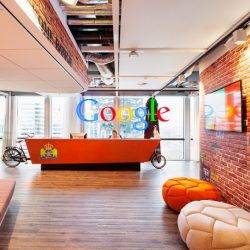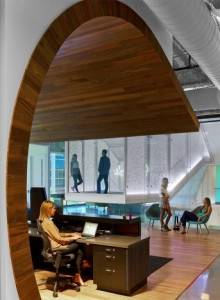 The open plan office versus closed debate rages on, and rather than running out of steam in the face of all of the evidence and reasoned argument put forward one one side or the other by many industry thought-leaders, it seems to have nine lives. Those grand and ground-breaking new offices occupied by the world’s tech giants seem to be particularly popular examples of why highly open and transparent workplaces do, or don’t work, especially those headline-grabbing offices created around the world by Google. This public debate has led to some very interesting and insightful discussions in various forums (to which I have contributed), inspiring me to synthesise the key themes into four reasons why a Google office is not necessarily the right type of office for your organisation. Many thanks in particular are due to David Rostie and Kay Sargent for their valuable online contributions to the debates which inspired this article.
The open plan office versus closed debate rages on, and rather than running out of steam in the face of all of the evidence and reasoned argument put forward one one side or the other by many industry thought-leaders, it seems to have nine lives. Those grand and ground-breaking new offices occupied by the world’s tech giants seem to be particularly popular examples of why highly open and transparent workplaces do, or don’t work, especially those headline-grabbing offices created around the world by Google. This public debate has led to some very interesting and insightful discussions in various forums (to which I have contributed), inspiring me to synthesise the key themes into four reasons why a Google office is not necessarily the right type of office for your organisation. Many thanks in particular are due to David Rostie and Kay Sargent for their valuable online contributions to the debates which inspired this article.
1. The ‘open’ versus ‘closed’ debate is the wrong discussion
Firstly, I am not alone in saying that the fundamental basis of the debate, i.e. ‘open plan versus offices’, is misconceived. The best performing workplaces are balanced. They are tuned to the unique mix of roles and types of people in an organisation, providing adequate access to places for collaboration, for focussed work and for more routine teamwork. An open plan office without enough of these spaces will undermine productivity, and result in tension and frustration among employees. Google (and many other companies) get this right for their unique combination of employee demographic, job functions and culture.
While the author of one article against open plan sees working from home as a potential solution, this option is not practical in many cities (especially in developing countries) or for many personal situations, although it can be an important element of flexible work programs. A holistic approach is needed that aligns in- and out-of-office options to provide as much flexibility and choice for as many people as possible, aligned with company values.

2. How you implement the change has a massive impact on employee perceptions
The second major element that is often overlooked in ‘against’ articles is that how you implement a new way of working is almost (or even equally!) as important to a successful employee outcome as what design you implement.
Many arguments against open plan appear to be understandably fuelled by the frustration and resentment resulting from having been ‘forced’ into an open plan environment by their employer (usually after what is perceived as many productive and happy years working in a private office).
People generally don’t like major change, and when they are not engaged, educated and empowered during and after the transition to a more open environment, the resentment is palpable.Companies with visionary leadership that help employees understand how and why their workplace supports individuals, teams and the company as a whole to achieve their goals, are generally far more likely to have productive and engaged employees in new environments.
A robust engagement and change strategy doesn’t hurt either – unfortunately many programs are less successful than they should be, primarily due to lack of said point above – visionary leadership! Google employees know what they are signing up for when they join, and as Google evolves as an organisation, their workplaces are slowly evolving (and learning from employee feedback) to keep pace.
3. The workplace is only as good as the behaviours of the people using it
Thirdly, any workplace design is only as effective as the behaviour of the people who occupy it – loud conversations, ‘camping’ in quiet rooms, using speakerphones and ignoring signs that a colleague needs to focus are all symptoms of a lack of etiquette-setting or enforcement. Many workplace ‘problems’ are cultural, managerial or technological, and need to be recognised and addressed as such.

4. Context matters – if you don’t work for Google, a Google office probably won’t work for you!
Context is everything; unfortunately too often the media conveniently forget this and prefer attention-seeking headlines and inappropriate use of terms such as ‘hotdesking’ which serves to confuse the argument even further. How a workplace looks, its trendy design and cool breakout spaces are only the visible (but still important) tip of the iceberg for having happy and productive employees.
What works for Google probably won’t work for your organisation. You probably have a different culture, brand, services or products, values, employee demographics, locations, leaders, customers, challenges, technology enablers…you get the drift.
Don’t forget also that Google is a diversified and evolving organisation and so its’ office designs are tailored to the country and culture, functions (for example sales versus engineering) and local business needs, and are constantly recalibrated based on feedback and learning’s. Google gets it right – for Google.
Be inspired yes, but not blinded by others organisations’ successful workplaces. If only it was as simple as open versus enclosed, but its not. Be smart and dig into why the space works for them (and what doesn’t work) – are there parallels to your organisation, or too many differences? Organisations and people are unique, dynamic, complex and reactive – your new office needs to be the same.
________________________
 Dr Caroline M. Burns is an international workplace consultant and mentor and is also Managing Director of Workplace Revolution. This feature originally appeared on her firm’s own website. This content is an original work by Dr. Caroline M. Burns and is copyright (C) by Dr. Caroline M. Burns. Dr. Burns does not endorse any advertising on republished sites and has not been paid for this contribution. All images: Rapt Studio designed office for Google’s Orange County HQ from 2015. Main image: Google Amsterdam.
Dr Caroline M. Burns is an international workplace consultant and mentor and is also Managing Director of Workplace Revolution. This feature originally appeared on her firm’s own website. This content is an original work by Dr. Caroline M. Burns and is copyright (C) by Dr. Caroline M. Burns. Dr. Burns does not endorse any advertising on republished sites and has not been paid for this contribution. All images: Rapt Studio designed office for Google’s Orange County HQ from 2015. Main image: Google Amsterdam.














July 5, 2018
Why a Google office simply does not work for everybody 0
by Dr Caroline M. Burns • Comment, Facilities management, Technology, Workplace design
1. The ‘open’ versus ‘closed’ debate is the wrong discussion
Firstly, I am not alone in saying that the fundamental basis of the debate, i.e. ‘open plan versus offices’, is misconceived. The best performing workplaces are balanced. They are tuned to the unique mix of roles and types of people in an organisation, providing adequate access to places for collaboration, for focussed work and for more routine teamwork. An open plan office without enough of these spaces will undermine productivity, and result in tension and frustration among employees. Google (and many other companies) get this right for their unique combination of employee demographic, job functions and culture.
While the author of one article against open plan sees working from home as a potential solution, this option is not practical in many cities (especially in developing countries) or for many personal situations, although it can be an important element of flexible work programs. A holistic approach is needed that aligns in- and out-of-office options to provide as much flexibility and choice for as many people as possible, aligned with company values.
2. How you implement the change has a massive impact on employee perceptions
The second major element that is often overlooked in ‘against’ articles is that how you implement a new way of working is almost (or even equally!) as important to a successful employee outcome as what design you implement.
Many arguments against open plan appear to be understandably fuelled by the frustration and resentment resulting from having been ‘forced’ into an open plan environment by their employer (usually after what is perceived as many productive and happy years working in a private office).
People generally don’t like major change, and when they are not engaged, educated and empowered during and after the transition to a more open environment, the resentment is palpable.Companies with visionary leadership that help employees understand how and why their workplace supports individuals, teams and the company as a whole to achieve their goals, are generally far more likely to have productive and engaged employees in new environments.
A robust engagement and change strategy doesn’t hurt either – unfortunately many programs are less successful than they should be, primarily due to lack of said point above – visionary leadership! Google employees know what they are signing up for when they join, and as Google evolves as an organisation, their workplaces are slowly evolving (and learning from employee feedback) to keep pace.
3. The workplace is only as good as the behaviours of the people using it
Thirdly, any workplace design is only as effective as the behaviour of the people who occupy it – loud conversations, ‘camping’ in quiet rooms, using speakerphones and ignoring signs that a colleague needs to focus are all symptoms of a lack of etiquette-setting or enforcement. Many workplace ‘problems’ are cultural, managerial or technological, and need to be recognised and addressed as such.
4. Context matters – if you don’t work for Google, a Google office probably won’t work for you!
Context is everything; unfortunately too often the media conveniently forget this and prefer attention-seeking headlines and inappropriate use of terms such as ‘hotdesking’ which serves to confuse the argument even further. How a workplace looks, its trendy design and cool breakout spaces are only the visible (but still important) tip of the iceberg for having happy and productive employees.
What works for Google probably won’t work for your organisation. You probably have a different culture, brand, services or products, values, employee demographics, locations, leaders, customers, challenges, technology enablers…you get the drift.
Don’t forget also that Google is a diversified and evolving organisation and so its’ office designs are tailored to the country and culture, functions (for example sales versus engineering) and local business needs, and are constantly recalibrated based on feedback and learning’s. Google gets it right – for Google.
Be inspired yes, but not blinded by others organisations’ successful workplaces. If only it was as simple as open versus enclosed, but its not. Be smart and dig into why the space works for them (and what doesn’t work) – are there parallels to your organisation, or too many differences? Organisations and people are unique, dynamic, complex and reactive – your new office needs to be the same.
________________________